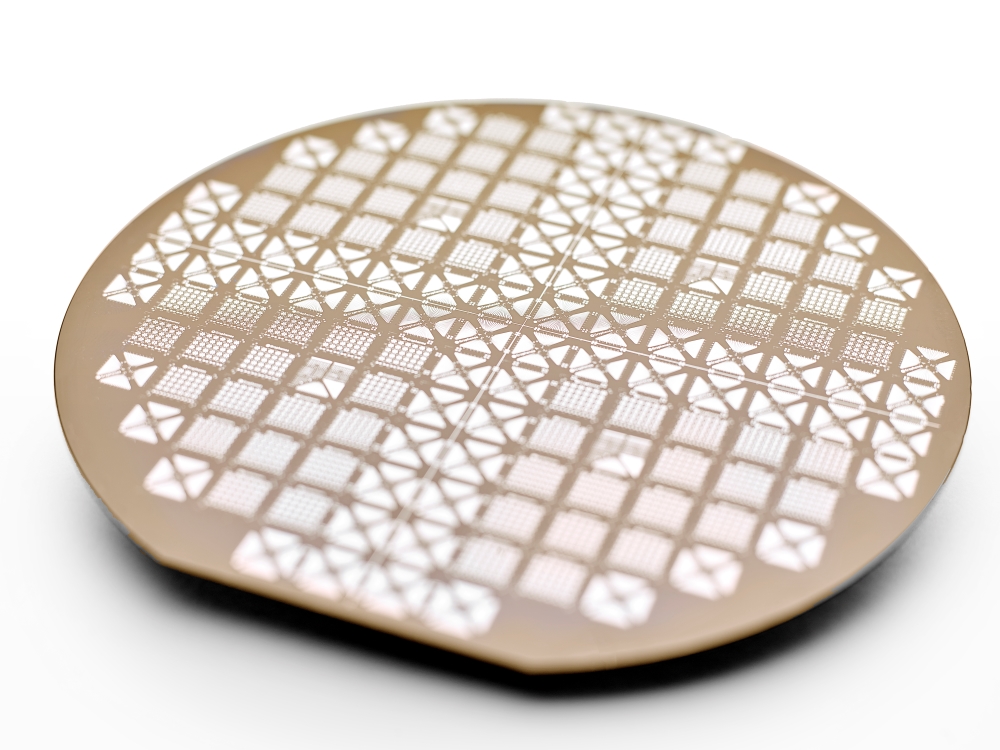Graphene is an atomically thin material, with properties that enable novel devices and technologies unachievable with conventional semiconductors such as silicon, germanium or compound materials. With Graphenea, you can prototype and develop graphene-based solid-state devices for applications in biosensing, optoelectronics and photonics.
Graphenea uses semiconductor manufacturing techniques to produce graphene-based devices at the wafer scale, such as resistors, capacitors, diodes, Hall sensor elements and field effect transistors. The foundry has three distinctive process flows that allow to fabricate these discrete components and even combine some of these devices within a single die, enabling the fabrication of simple circuitry.
Graphenea’s proprietary fabrication processes enable them to guarantee metrics in their runs, ensuring the customer’s devices are up to standards. Moreover, short manufacturing cycles use far less resources compared to those of traditional silicon, reducing the amount of water, gases and other chemicals and materials, significantly reducing their carbon footprint.
Process Flow 1 enables the manufacturing of general-purpose devices, such as 2-terminal resistors, capacitors, 3-terminal FETs, and 4-terminal Hall bars if the substrate is contacted. This allows for the application of a global gate voltage, enabling a wide range of applications, including magnetic sensing, volatile organic compounds (VOCs) sensing, and gas sensing, to name a few.
Graphenea Process Flow 1 – General | |||
|---|---|---|---|
Transistors | CVD-graphene
gated through substrate | Ambipolar FET p-type at VG=0 | Width=10µm Length=10µm |
Resistors | CVD-graphene | p-type, 1kOhm/sq | Width=10µm Length= 10µm |
Substrate | SiO2/Si | SiO2=90nm Si=525µm | |
Metal contacts | Au | CD=10µm Thickness = 50nm | |
QC | Carrier transport | In PCM dies | Mobility >1000cm2/V·s Dirac Point<20V Hysteresis<10V |
Raman | In PCM dies | Raman · I(G)/I(2D) < 1.25 · I(D)/I(G) < 0.15 · Pos(G) < 1600 cm-1 · FWHM(2D) < 45 cm-1 | |
Optical | In PCM dies | Channel integrity > 95% Device yield within die > 75% | |
Process Flow 2 is tailored for liquid sample measurements, offering features particularly suited for biosensing and liquid biopsies. The passivated contacts prevent large leakage currents and device degradation upon contact with the liquid analyte, enabling measurements in saline solutions, as well as biological fluids like blood, plasma, saliva, and sweat.
Graphenea Process Flow 2 – Biosensing | |||
|---|---|---|---|
Transistors | CVD-graphene
gated through substrate | Ambipolar FET p-type at VG=0 | Width=10µm Length=10µm |
Resistors | CVD-graphene | p-type, 1kOhm/sq | Width=10µm Length= 10µm |
Substrate | SiO2/Si | SiO2=90nm Si=525µm | |
Metal contacts | Au | CD=10µm Thickness = 50nm | |
Encapsulation | Al2O3 | CD=10µm Thickness = 30nm | |
Via opening | CD=10µm | ||
QC | Carrier transport | In PCM dies | Mobility >1000cm2/V·s Dirac Point<20V Hysteresis<10V |
Raman | In PCM dies | Raman · I(G)/I(2D) < 1.25 · I(D)/I(G) < 0.15 · Pos(G) < 1600 cm-1 · FWHM(2D) < 45 cm-1 | |
Optical | In PCM dies | Channel integrity > 95% Device yield within die > 75% | |
Process Flow 3 focuses on the implementation of High-K Metal Gate (HKMG) devices, allowing for individual gating and charge modulation, which dramatically increases the versatility and complexity of graphene-based devices and circuits. This process flow has two flavours:
Graphenea Process Flow 3 – HKMG | |||
|---|---|---|---|
Transistors | CVD-graphene
gated through local gate | Ambipolar FET p-type at VG=0 | Width=10µm Length=10µm |
Resistors | CVD-graphene | p-type, 1kOhm/sq | Width=10µm Length= 10µm |
Capacitor | Metal/Al2O3/Metal Metal/Al2O3/Graphene | K=11
| Min. Thickness= 12mn Max. Thickness= 240nm CD=10µm |
Substrate | SiO2/Si | SiO2=90nm Si=525µm | |
Metal contacts | Au | CD=10µm Thickness = 50nm | |
Gate Dielectric | Al2O3 | CD=10µm Thickness = 40nm | |
Metal gate | Au | CD=10µm Thickness = 50nm | |
Via opening | CD=10µm | ||
QC | Carrier transport | In PCM dies | Mobility >500cm2/V·s Dirac Point<5V Hysteresis<0.1V |
Raman | In PCM dies | Raman · I(G)/I(2D) < 1.25 · I(D)/I(G) < 0.15 · Pos(G) < 1600 cm-1 · FWHM(2D) < 45 cm-1 | |
Optical | In PCM dies | Channel integrity > 95% Device yield within die > 75% | |

